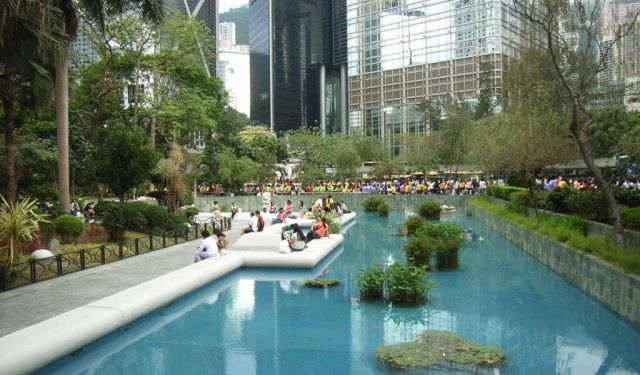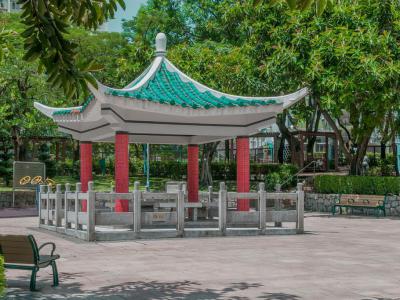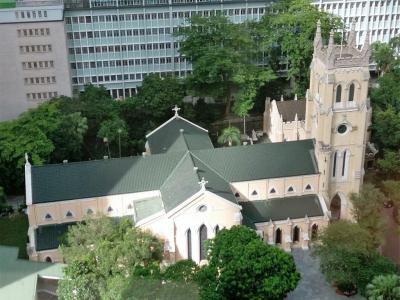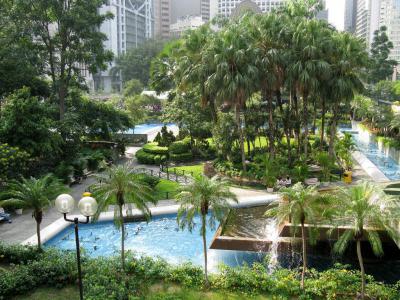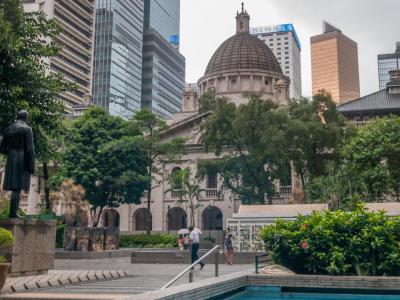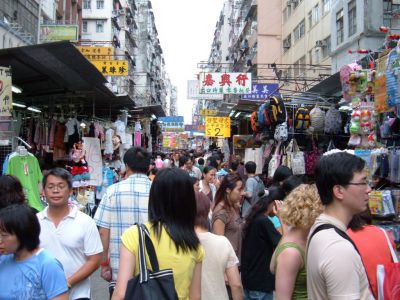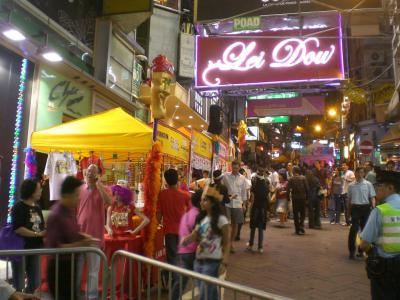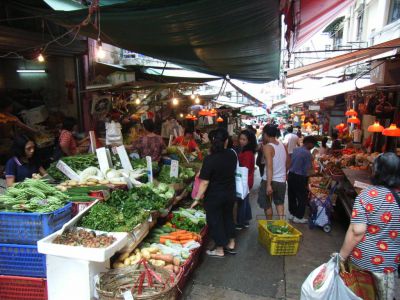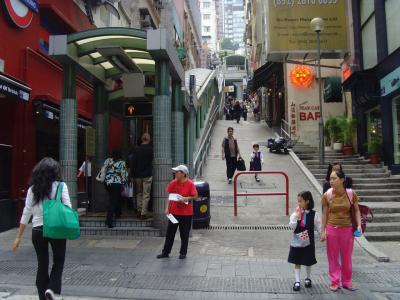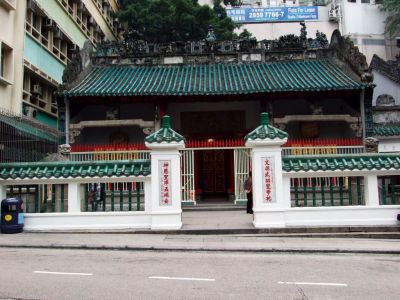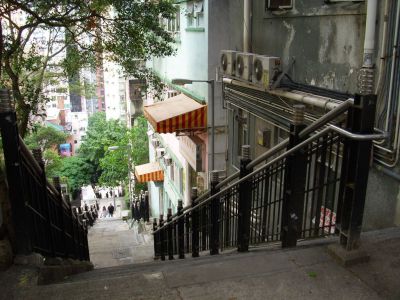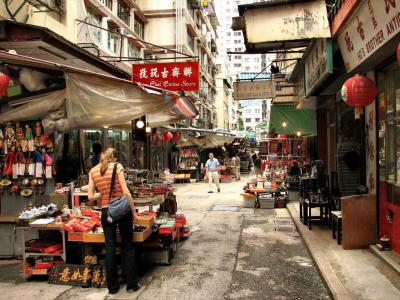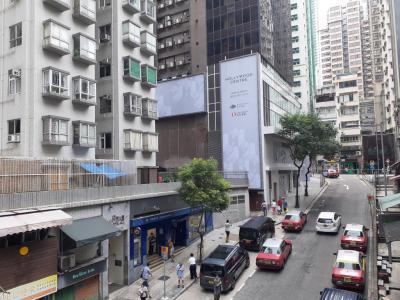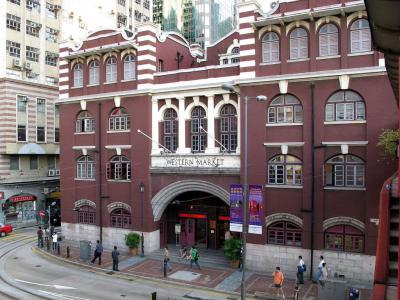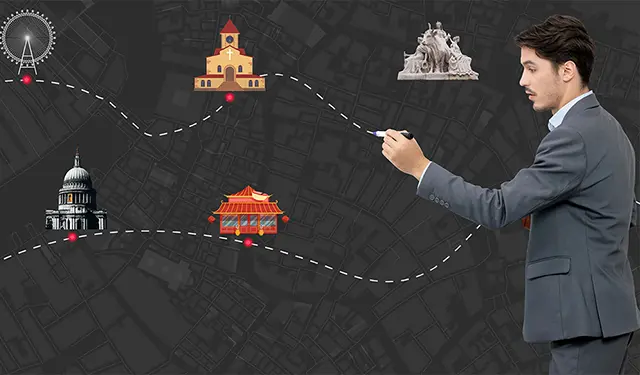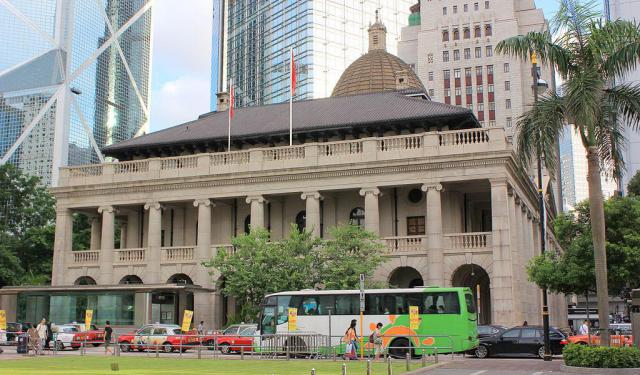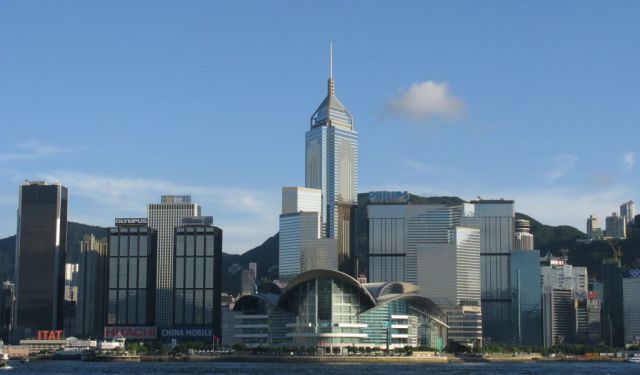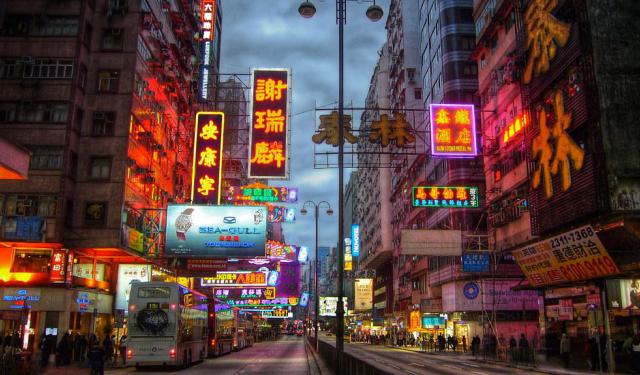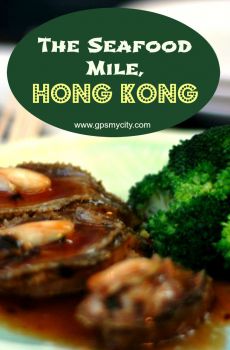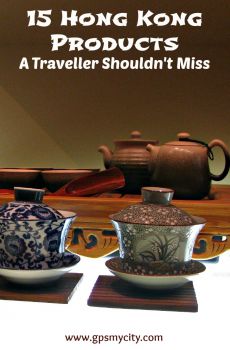Downtown Introduction Walking Tour (Self Guided), Hong Kong
Hong Kong is a city defined by contrasts—towering glass skylines rising beside quiet temples and centuries of culture. Even its name, from the Cantonese Heung Gong, meaning “Fragrant Harbor”, hints at its early role as a trading point for incense woods and aromatic goods moving through the Pearl River Delta. What began as the name of a small village near the present-day Aberdeen area eventually grew to represent one of the world’s most dynamic urban centers.
Downtown Hong Kong began to take form in the mid-19th century, when the island came under British rule. After the Treaty of Nanking in 1842, the agreement that ended the First Opium War between the Qing Dynasty of China and Britain, the British established Victoria City along the northern shoreline, laying the foundations of what would become the city’s financial and administrative heart. At first, it was a modest settlement of government offices, merchants’ houses, and wooden piers—but its deep natural harbor quickly transformed it into a major trading hub, attracting ships, goods, and opportunity from across Asia and beyond.
By the late 19th century, this waterfront district had become a bustling multicultural center where Chinese and foreign merchants worked side by side. Ambitious land reclamation projects pushed the shoreline outward, creating new streets and business corridors. Central district developed into the colony’s administrative and financial core, while Sheung Wan district thrived as a center of Chinese commerce, filled with markets, traditional shops, and busy warehouses.
The early 20th century brought electric trams, new public works, and modern banks that reshaped the cityscape. Despite the hardships of the Japanese occupation, postwar Hong Kong rebounded with astonishing speed. Downtown shifted upward and outward, becoming a dense vertical metropolis whose walkways, skyscrapers, and ever-evolving skyline reflected the city’s growing global role.
Today, a walk through downtown reveals this rich blend of history and modern energy. Statue Square and Chater Garden offer moments of calm between corporate towers. Saint John’s Cathedral stands as a reminder of early colonial architecture. The Central Mid-Levels Escalators lift you through layers of cafes and boutique streets, while Graham Street Wet Market bursts with everyday color. Farther west, the restored Western Market preserves the textures of early 20th-century Hong Kong.
Downtown may look relentlessly modern, but it’s the older details that give it rhythm. Markets, temples, arcades, and glass towers fold into a single urban narrative. This walk ties those threads together—showing you a Hong Kong that’s both familiar and constantly changing.
Downtown Hong Kong began to take form in the mid-19th century, when the island came under British rule. After the Treaty of Nanking in 1842, the agreement that ended the First Opium War between the Qing Dynasty of China and Britain, the British established Victoria City along the northern shoreline, laying the foundations of what would become the city’s financial and administrative heart. At first, it was a modest settlement of government offices, merchants’ houses, and wooden piers—but its deep natural harbor quickly transformed it into a major trading hub, attracting ships, goods, and opportunity from across Asia and beyond.
By the late 19th century, this waterfront district had become a bustling multicultural center where Chinese and foreign merchants worked side by side. Ambitious land reclamation projects pushed the shoreline outward, creating new streets and business corridors. Central district developed into the colony’s administrative and financial core, while Sheung Wan district thrived as a center of Chinese commerce, filled with markets, traditional shops, and busy warehouses.
The early 20th century brought electric trams, new public works, and modern banks that reshaped the cityscape. Despite the hardships of the Japanese occupation, postwar Hong Kong rebounded with astonishing speed. Downtown shifted upward and outward, becoming a dense vertical metropolis whose walkways, skyscrapers, and ever-evolving skyline reflected the city’s growing global role.
Today, a walk through downtown reveals this rich blend of history and modern energy. Statue Square and Chater Garden offer moments of calm between corporate towers. Saint John’s Cathedral stands as a reminder of early colonial architecture. The Central Mid-Levels Escalators lift you through layers of cafes and boutique streets, while Graham Street Wet Market bursts with everyday color. Farther west, the restored Western Market preserves the textures of early 20th-century Hong Kong.
Downtown may look relentlessly modern, but it’s the older details that give it rhythm. Markets, temples, arcades, and glass towers fold into a single urban narrative. This walk ties those threads together—showing you a Hong Kong that’s both familiar and constantly changing.
How it works: Download the app "GPSmyCity: Walks in 1K+ Cities" from Apple App Store or Google Play Store to your mobile phone or tablet. The app turns your mobile device into a personal tour guide and its built-in GPS navigation functions guide you from one tour stop to next. The app works offline, so no data plan is needed when traveling abroad.
Downtown Introduction Walking Tour Map
Guide Name: Downtown Introduction Walking Tour
Guide Location: Hong Kong » Hong Kong (See other walking tours in Hong Kong)
Guide Type: Self-guided Walking Tour (Sightseeing)
# of Attractions: 13
Tour Duration: 2 Hour(s)
Travel Distance: 3.7 Km or 2.3 Miles
Author: emma
Sight(s) Featured in This Guide:
Guide Location: Hong Kong » Hong Kong (See other walking tours in Hong Kong)
Guide Type: Self-guided Walking Tour (Sightseeing)
# of Attractions: 13
Tour Duration: 2 Hour(s)
Travel Distance: 3.7 Km or 2.3 Miles
Author: emma
Sight(s) Featured in This Guide:
- Hong Kong Park
- St. John's Cathedral
- Chater Garden
- Statue Square
- Li Yuen Street East
- Lan Kwai Fong
- Graham Street Wet Market
- Central Mid-Levels Escalators
- Man Mo Temple
- Ladder Street
- Cat Street Market
- Possession Street
- Western Market
1) Hong Kong Park (must see)
What was once a military site and later used by a school has been transformed into a place where trees, water and heritage mingle with urban surroundings. Hong Kong Park opened to the public in May 1991 on grounds that once belonged to the old Victoria Barracks, a large British military complex. It spans about eight hectares, offering a surprisingly calm green retreat.
As you stroll in, you’ll find paths winding under leafy canopies, around an artificial lake with koi and turtles, past a waterfall, streams and ponds. Historic buildings from the colonial era remain: the elegant Flagstaff House, erected in 1846, now welcomes visitors as the Flagstaff House Museum of Tea Ware, while the former barracks buildings like Cassels Block house the Hong Kong Visual Arts Center.
For a twist beyond gardens and history, the park’s standout attraction is the Edward Youde Aviary — one of the largest walk-through aviaries of its kind. Here you’ll wander along elevated wooden pathways through lush greenery, while over 500 birds — many from tropical rainforests far beyond Hong Kong — fly overhead or perch in treetops. Below them, streams and ponds complete a verdant, almost jungle-like atmosphere.
As you enter from Kennedy Road, the first feature you meet is the Children’s Playground. On your left stands the Hong Kong Visual Arts Center, and just beyond it lies the Hong Kong Park Sports Center. To the right of the playground is the Edward Youde Aviary. If you continue walking past the aviary, you’ll reach the Fighting SARS Memorial and the adjacent Tai Chi Garden. From here, head north-east toward the Lake, a quiet spot with koi, turtles and a small waterfall. Continuing uphill in the same direction brings you to the Flagstaff House Museum of Tea Ware, the most prominent historic structure in the park.
As you stroll in, you’ll find paths winding under leafy canopies, around an artificial lake with koi and turtles, past a waterfall, streams and ponds. Historic buildings from the colonial era remain: the elegant Flagstaff House, erected in 1846, now welcomes visitors as the Flagstaff House Museum of Tea Ware, while the former barracks buildings like Cassels Block house the Hong Kong Visual Arts Center.
For a twist beyond gardens and history, the park’s standout attraction is the Edward Youde Aviary — one of the largest walk-through aviaries of its kind. Here you’ll wander along elevated wooden pathways through lush greenery, while over 500 birds — many from tropical rainforests far beyond Hong Kong — fly overhead or perch in treetops. Below them, streams and ponds complete a verdant, almost jungle-like atmosphere.
As you enter from Kennedy Road, the first feature you meet is the Children’s Playground. On your left stands the Hong Kong Visual Arts Center, and just beyond it lies the Hong Kong Park Sports Center. To the right of the playground is the Edward Youde Aviary. If you continue walking past the aviary, you’ll reach the Fighting SARS Memorial and the adjacent Tai Chi Garden. From here, head north-east toward the Lake, a quiet spot with koi, turtles and a small waterfall. Continuing uphill in the same direction brings you to the Flagstaff House Museum of Tea Ware, the most prominent historic structure in the park.
2) St. John's Cathedral
Of the few cathedrals in Hong Kong, the Cathedral Church of Saint John the Evangelist – commonly known as Saint John’s Cathedral – is the oldest. Like Holy Trinity Cathedral and All Saints’ Cathedral, Saint John’s is Anglican. Completed in 1849 and consecrated in 1852, it is not only the oldest cathedral in Hong Kong but also the oldest Anglican church in the Far East.
Designed in the English Gothic Revival style, the cathedral is built from stucco and wood, with a simple cross-shaped plan and an understated, early English–inspired interior that contrasts with the surrounding skyscrapers. Inside, memorial tablets, stained-glass windows and a prominent chancel recall its long role as the main Anglican church for the city. Today it serves as the cathedral of the Anglican Diocese of Hong Kong Island and the mother church of the Province of Hong Kong Sheng Kung Hui.
The building has also lived through some of Hong Kong’s hardest moments. During the Japanese occupation in World War II, Saint John’s was turned into a club for Japanese forces, and many original fittings – including stained glass designed by William Morris’s firm – were stripped out. After the war, services resumed and the cathedral was gradually restored; in 1996 it was declared a monument, recognizing its importance as the oldest surviving Western ecclesiastical building in Hong Kong.
Visitors are welcome to attend services at Saint John’s. The cathedral now holds multiple services across Saturdays and Sundays, with a quieter lunchtime meditation on Mondays that offers a brief pause in the middle of the working week. Wednesday lunchtime performances are often held here, and there is also a small cafe on the cathedral grounds, The Nest, serving drinks and light snacks.
Designed in the English Gothic Revival style, the cathedral is built from stucco and wood, with a simple cross-shaped plan and an understated, early English–inspired interior that contrasts with the surrounding skyscrapers. Inside, memorial tablets, stained-glass windows and a prominent chancel recall its long role as the main Anglican church for the city. Today it serves as the cathedral of the Anglican Diocese of Hong Kong Island and the mother church of the Province of Hong Kong Sheng Kung Hui.
The building has also lived through some of Hong Kong’s hardest moments. During the Japanese occupation in World War II, Saint John’s was turned into a club for Japanese forces, and many original fittings – including stained glass designed by William Morris’s firm – were stripped out. After the war, services resumed and the cathedral was gradually restored; in 1996 it was declared a monument, recognizing its importance as the oldest surviving Western ecclesiastical building in Hong Kong.
Visitors are welcome to attend services at Saint John’s. The cathedral now holds multiple services across Saturdays and Sundays, with a quieter lunchtime meditation on Mondays that offers a brief pause in the middle of the working week. Wednesday lunchtime performances are often held here, and there is also a small cafe on the cathedral grounds, The Nest, serving drinks and light snacks.
3) Chater Garden
Chater Garden offers an inviting open space in the middle of the busy financial area of the city, making it an ideal place to pause and enjoy its pools, small waterfalls and fountains. It was named after Sir Paul Chater, a prominent British-Indian businessman of Armenian descent whose influence on early 20th-century Hong Kong development was immense. Chater Road, which borders one side of the garden, also commemorates him.
Because of its central location near government buildings, the garden has become a common site for political rallies, peaceful demonstrations and public gatherings. Historically, this area was once occupied by the Hong Kong Cricket Club, which played here from 1851 until 1975. After the club relocated to Wong Nai Chung Gap, the site was redeveloped and officially opened to the public in 1978.
Part of the garden sits on land that was once reclaimed from Victoria Harbour during one of Central’s major land reclamation phases. This means that where visitors stand today—surrounded by pools, fountains and greenery—was once open water.
Because of its central location near government buildings, the garden has become a common site for political rallies, peaceful demonstrations and public gatherings. Historically, this area was once occupied by the Hong Kong Cricket Club, which played here from 1851 until 1975. After the club relocated to Wong Nai Chung Gap, the site was redeveloped and officially opened to the public in 1978.
Part of the garden sits on land that was once reclaimed from Victoria Harbour during one of Central’s major land reclamation phases. This means that where visitors stand today—surrounded by pools, fountains and greenery—was once open water.
4) Statue Square
Statue Square is a green-open square, siting in a lively business and shopping district flanked by some of the city’s most amazing buildings. Its name might mislead first-time visitors into thinking it refers only to the single statue still standing there today. In fact, the square was originally lined with many statues of British royalty and colonial-era personages.
The very first was a statue of Queen Victoria, unveiled in 1896 to mark her Golden Jubilee. Over time, additional statues were added — including the Duke of Connaught, King Edward VII, King George V, Queen Alexandra, Mary of Teck, and a First World War memorial statue titled “Fame”. The square was originally called “Royal Square”, a name that reflected its purpose as a public display of colonial statuary.
That era ended during World War II: under Japanese occupation, most of the statues were removed and sent to Japan to be melted down. After the war, only one statue returned to its original place in the square — that of Sir Thomas Jackson, 1st Baronet, former chief manager of the Hongkong and Shanghai Banking Corporation — which now stands roughly in the center of Statue Square. Meanwhile, the statues of Queen Victoria and the two HSBC lions were all discovered in Kobe, Japan, and were brought back to Hong Kong together aboard the same ship in October 1946.
Today, skyscrapers, corporate towers, and the former Supreme Court building make up its backdrop. Near the northern edge of the square stands The Cenotaph, an elegant war memorial unveiled in 1923. The Cenotaph honors victims of World War I and II and remains a solemn, widely respected monument.
The very first was a statue of Queen Victoria, unveiled in 1896 to mark her Golden Jubilee. Over time, additional statues were added — including the Duke of Connaught, King Edward VII, King George V, Queen Alexandra, Mary of Teck, and a First World War memorial statue titled “Fame”. The square was originally called “Royal Square”, a name that reflected its purpose as a public display of colonial statuary.
That era ended during World War II: under Japanese occupation, most of the statues were removed and sent to Japan to be melted down. After the war, only one statue returned to its original place in the square — that of Sir Thomas Jackson, 1st Baronet, former chief manager of the Hongkong and Shanghai Banking Corporation — which now stands roughly in the center of Statue Square. Meanwhile, the statues of Queen Victoria and the two HSBC lions were all discovered in Kobe, Japan, and were brought back to Hong Kong together aboard the same ship in October 1946.
Today, skyscrapers, corporate towers, and the former Supreme Court building make up its backdrop. Near the northern edge of the square stands The Cenotaph, an elegant war memorial unveiled in 1923. The Cenotaph honors victims of World War I and II and remains a solemn, widely respected monument.
5) Li Yuen Street East
Li Yuen Street East holds historical significance as the first street in colonial Hong Kong named after a local Chinese citizen: Kim Li Yuen, a prosperous merchant from Guangdong province who, in 1894, acquired a portion of newly reclaimed land and commissioned the development of this lane. In its early days the lane consisted of mixed-use buildings — with shops on the ground floors and apartments above — rather than the bustling stalls for which it is known today.
After World War II, the street gained a new identity: several newspaper offices and printing workshops were established there, and for a time it earned the nickname “Newspaper Street”. Freshly printed newspapers were distributed across Hong Kong each morning from this street.
As the city changed and the media offices left, Li Yuen Street East evolved once more: street-stall vendors replaced the newspapers, and gradually the street turned into a lively open-air market. Today, it’s a bustling tourist-market lane famed for inexpensive clothing, accessories, souvenirs and daily goods. Some visitors fondly refer to it as “Central’s Women Street”, reminiscent of similar market streets elsewhere in Hong Kong.
For modern visitors, Li Yuen Street East offers a very different slice of Hong Kong life compared to polished malls: narrow alleys, packed stalls, bargaining energy, and a colorful mix of locals and tourists.
After World War II, the street gained a new identity: several newspaper offices and printing workshops were established there, and for a time it earned the nickname “Newspaper Street”. Freshly printed newspapers were distributed across Hong Kong each morning from this street.
As the city changed and the media offices left, Li Yuen Street East evolved once more: street-stall vendors replaced the newspapers, and gradually the street turned into a lively open-air market. Today, it’s a bustling tourist-market lane famed for inexpensive clothing, accessories, souvenirs and daily goods. Some visitors fondly refer to it as “Central’s Women Street”, reminiscent of similar market streets elsewhere in Hong Kong.
For modern visitors, Li Yuen Street East offers a very different slice of Hong Kong life compared to polished malls: narrow alleys, packed stalls, bargaining energy, and a colorful mix of locals and tourists.
6) Lan Kwai Fong
Lan Kwai Fong is a small cluster of narrow, cobblestone streets in Central Hong Kong — one of the city’s most famous districts for dining, drinking and nightlife. Historically, before the Second World War, the area was home to hawkers and street vendors. In its earlier days, the lanes of Lan Kwai Fong were better known as a place where female match-makers worked — arranging marriages for families — so the area was sometimes called “Matchmaker’s Lane”.
The transformation that turned Lan Kwai Fong into the nightlife hotspot began in the late 1970s and early 1980s. One key moment came in 1983, when entrepreneur Allan Zeman — often called “the Father of Lan Kwai Fong” — opened a Western-style restaurant called “California”. What started as a casual dining venue quickly evolved and Zeman went on to purchase entire blocks in the area, helping to reshape its image and lay the foundation for the lively bar and club district it is nowadays.
Today Lan Kwai Fong is packed with bars, restaurants, clubs and live-music venues. You can visit “The Iron Fairies” — a bar filled with wrought-iron decor and a scene for live jazz, blues and DJ-driven nights. For a more club-style outing, “Dragon-i” brings energetic dance music, often drawing a mix of locals, expats and night-owl travelers.
Tip:
For the best experience consider arriving before 9 PM, when many venues still offer “happy hour” pricing and the crowds haven’t yet peaked.
The transformation that turned Lan Kwai Fong into the nightlife hotspot began in the late 1970s and early 1980s. One key moment came in 1983, when entrepreneur Allan Zeman — often called “the Father of Lan Kwai Fong” — opened a Western-style restaurant called “California”. What started as a casual dining venue quickly evolved and Zeman went on to purchase entire blocks in the area, helping to reshape its image and lay the foundation for the lively bar and club district it is nowadays.
Today Lan Kwai Fong is packed with bars, restaurants, clubs and live-music venues. You can visit “The Iron Fairies” — a bar filled with wrought-iron decor and a scene for live jazz, blues and DJ-driven nights. For a more club-style outing, “Dragon-i” brings energetic dance music, often drawing a mix of locals, expats and night-owl travelers.
Tip:
For the best experience consider arriving before 9 PM, when many venues still offer “happy hour” pricing and the crowds haven’t yet peaked.
7) Graham Street Wet Market
Graham Street Wet Market is one of Hong Kong’s oldest surviving street markets, operating for more than 160 years. In the past, redevelopment plans raised real concern that the market might be demolished entirely, but the current Urban Renewal Project has shifted toward a preservation-and-renovation approach. Today the market remains open to visitors, and while sections of the neighborhood are being upgraded, much of its traditional character is still intact, offering a rare window into Hong Kong’s everyday life and its long history as a hub for fresh produce and street-side commerce.
Despite its name, the market extends far beyond Graham Street. Stalls spill across Gage Street, Peel Street and Stanley Street, turning the surrounding lanes into a colorful and crowded web of fresh produce, herbs, vegetables and flowers. The narrow alleys buzz with vendors calling out their daily offerings, giving the entire market a lively, distinctly local rhythm. One charming detail is that some vendors still use traditional hand-painted signs, a rarity in modern Hong Kong.
Graham Street Market is also a great stop for a quick meal. Longtime shoppers often point out that this market once supplied nearby dai pai dongs — Hong Kong’s famous open-air food stalls. Noodle stands, bakeries and ready-to-eat street food options make it easy to grab lunch on the go, while those with a kitchen at hand can pick up everything from seafood to poultry and seasonal vegetables.
Despite its name, the market extends far beyond Graham Street. Stalls spill across Gage Street, Peel Street and Stanley Street, turning the surrounding lanes into a colorful and crowded web of fresh produce, herbs, vegetables and flowers. The narrow alleys buzz with vendors calling out their daily offerings, giving the entire market a lively, distinctly local rhythm. One charming detail is that some vendors still use traditional hand-painted signs, a rarity in modern Hong Kong.
Graham Street Market is also a great stop for a quick meal. Longtime shoppers often point out that this market once supplied nearby dai pai dongs — Hong Kong’s famous open-air food stalls. Noodle stands, bakeries and ready-to-eat street food options make it easy to grab lunch on the go, while those with a kitchen at hand can pick up everything from seafood to poultry and seasonal vegetables.
8) Central Mid-Levels Escalators
You don’t need to hike a mountain to climb Hong Kong Island — the Central–Mid-Levels Escalators will do the work for you. This system is the longest covered outdoor escalator network in the world. Stretching over eight hundred meters and rising more than one hundred and thirty-five meters from bottom to top, it was completed in 1993 to provide a smoother commute between the Western and Central Districts on Hong Kong Island.
Much of Hong Kong Island is steep and hilly, making it challenging for residents and visitors to move easily up and down the slopes. This terrain has led the city to adopt a number of unusual and innovative transport solutions, designed to make daily life more accessible for everyone. Passing through a series of narrow streets and elevated walkways, the system links Des Voeux Road in Central with Conduit Road in the Mid-Levels. It carries more than 50,000 people each day.
A fun detail is that the escalators don’t run in the same direction all day. Each morning they flow downhill to help commuters reach Central, and around 10 am they switch to an uphill climb for the rest of the day. Locals also treat the escalator route as a kind of moving walkway between cafes, bars and small shops, making it one of the easiest ways to explore the surrounding neighborhoods.
Much of Hong Kong Island is steep and hilly, making it challenging for residents and visitors to move easily up and down the slopes. This terrain has led the city to adopt a number of unusual and innovative transport solutions, designed to make daily life more accessible for everyone. Passing through a series of narrow streets and elevated walkways, the system links Des Voeux Road in Central with Conduit Road in the Mid-Levels. It carries more than 50,000 people each day.
A fun detail is that the escalators don’t run in the same direction all day. Each morning they flow downhill to help commuters reach Central, and around 10 am they switch to an uphill climb for the rest of the day. Locals also treat the escalator route as a kind of moving walkway between cafes, bars and small shops, making it one of the easiest ways to explore the surrounding neighborhoods.
9) Man Mo Temple
Among all the temples throughout Hong Kong honoring Man Tai, the Taoist God of Culture and Literature, and Mo Tai, the God of War, Man Mo Temple is the most historically significant and it is the largest and one of the oldest Man Mo temples in the city. Built beginning in 1847, it reflects Qing Dynasty architecture with its green tiled roof, intricate carvings, and richly decorated interior.
The temple is still active, and visitors are welcome to enter free of charge. Once you step inside from Hollywood Road, the first thing you’ll notice is the haze of spiraling incense coils suspended from the ceiling. Many of them burn for days, each coil bearing a small red prayer tag left by worshipers. Walk a little farther into the main hall and you’ll see elaborate wooden carvings framing the altars, along with golden statues of Man Tai and Mo Tai. To your left, near the entrance, you’ll find a fortune-telling counter, where a Taoist practitioner offers traditional kau cim readings.
To explore the rest of the complex, continue walking straight through the central chamber. Litt Shing Kung, the hall dedicated to all gods, stands just behind the main altar area. To reach Kung Sor, the old community assembly hall, turn left from the central hall before exiting the rear of the temple. This side chamber once served as a community assembly room, where elders settled disputes and discussed village matters. Today it displays historical tablets, ceremonial furniture, and old inscriptions that hint at its former civic role.
The temple is still active, and visitors are welcome to enter free of charge. Once you step inside from Hollywood Road, the first thing you’ll notice is the haze of spiraling incense coils suspended from the ceiling. Many of them burn for days, each coil bearing a small red prayer tag left by worshipers. Walk a little farther into the main hall and you’ll see elaborate wooden carvings framing the altars, along with golden statues of Man Tai and Mo Tai. To your left, near the entrance, you’ll find a fortune-telling counter, where a Taoist practitioner offers traditional kau cim readings.
To explore the rest of the complex, continue walking straight through the central chamber. Litt Shing Kung, the hall dedicated to all gods, stands just behind the main altar area. To reach Kung Sor, the old community assembly hall, turn left from the central hall before exiting the rear of the temple. This side chamber once served as a community assembly room, where elders settled disputes and discussed village matters. Today it displays historical tablets, ceremonial furniture, and old inscriptions that hint at its former civic role.
10) Ladder Street
Ladder Street is a continuous ascent of granite steps that reflects the city’s early struggle to build streets on steep, mountainous terrain. Created in the mid-19th century, when Sheung Wan was one of the first Chinese residential districts on Hong Kong Island, the street was engineered entirely as a stone staircase because the hillside was too steep for traditional roads. Much of this original construction survives today, making Ladder Street a rare example of Hong Kong’s earliest urban design.
As you climb, the street reveals layers of history—ancestral shops, temple structures, and century-old institutions—woven into one of the city’s most atmospheric pedestrian routes. Near the lower section, you’ll walk past the Bridges Street Market, a restored 1950s Bauhaus-style structure easily recognizable by its curved concrete facade and horizontal windows. Continue climbing toward Caine Lane and you’ll see the red-brick Hong Kong Museum of Medical Sciences rising beside the steps — one of the neighborhood’s most impressive heritage buildings.
Ladder Street begins near Queen’s Road Central and climbs sharply toward the Mid-Levels, linking several historic areas including Hollywood Road, Cat Street and Po Hing Fong street. Though the granite steps themselves have remained largely unchanged since the mid-19th century, the surrounding buildings have been repeatedly rebuilt, creating a contrast between old and new.
As you climb, the street reveals layers of history—ancestral shops, temple structures, and century-old institutions—woven into one of the city’s most atmospheric pedestrian routes. Near the lower section, you’ll walk past the Bridges Street Market, a restored 1950s Bauhaus-style structure easily recognizable by its curved concrete facade and horizontal windows. Continue climbing toward Caine Lane and you’ll see the red-brick Hong Kong Museum of Medical Sciences rising beside the steps — one of the neighborhood’s most impressive heritage buildings.
Ladder Street begins near Queen’s Road Central and climbs sharply toward the Mid-Levels, linking several historic areas including Hollywood Road, Cat Street and Po Hing Fong street. Though the granite steps themselves have remained largely unchanged since the mid-19th century, the surrounding buildings have been repeatedly rebuilt, creating a contrast between old and new.
11) Cat Street Market
Cat Street Market is one of Hong Kong’s most distinctive spots for browsing antiques and vintage collectibles. Once known as a hub for traders dealing in second-hand goods, it has evolved into a lively flea-market–style street where stalls and small shops display everything from traditional Chinese crafts to quirky souvenirs.
Visitors will find jade carvings, calligraphy scrolls, Cultural Revolution memorabilia, old coins, teapots, decorative porcelain, and vintage advertising posters. Some shops offer genuine antiques, while others sell replicas or reproduction items — which is part of the market’s charm, though travelers should keep in mind that authenticity varies widely.
In addition to antiques, Cat Street is known for its selection of hand-painted artwork, ceramic pieces, Tibetan-style jewelry, and secondhand books. A few shops also sell carpets and small furniture pieces, though these are less dominant than in the past. Many stalls display Mao-era souvenirs such as “Red Book” replicas, enamel pins, posters and other Cultural Revolution–themed items that attract collectors and curious tourists alike.
One advantage for shoppers is that prices are usually more reasonable than in Hong Kong’s high-end antique galleries. Bargaining is common, especially for decorative pieces, and many imported goods are offered at competitive, sometimes tax-free prices. Even if you don’t purchase anything, Cat Street Market is a memorable stop for its eclectic mix of old Hong Kong charm, colorful objects and treasure-hunt atmosphere.
Visitors will find jade carvings, calligraphy scrolls, Cultural Revolution memorabilia, old coins, teapots, decorative porcelain, and vintage advertising posters. Some shops offer genuine antiques, while others sell replicas or reproduction items — which is part of the market’s charm, though travelers should keep in mind that authenticity varies widely.
In addition to antiques, Cat Street is known for its selection of hand-painted artwork, ceramic pieces, Tibetan-style jewelry, and secondhand books. A few shops also sell carpets and small furniture pieces, though these are less dominant than in the past. Many stalls display Mao-era souvenirs such as “Red Book” replicas, enamel pins, posters and other Cultural Revolution–themed items that attract collectors and curious tourists alike.
One advantage for shoppers is that prices are usually more reasonable than in Hong Kong’s high-end antique galleries. Bargaining is common, especially for decorative pieces, and many imported goods are offered at competitive, sometimes tax-free prices. Even if you don’t purchase anything, Cat Street Market is a memorable stop for its eclectic mix of old Hong Kong charm, colorful objects and treasure-hunt atmosphere.
12) Possession Street
Possession Street is often associated with the moment when Hong Kong officially came under British possession, marks the boundary between Queen’s Road West and Queen’s Road Central.
On 20 January 1841, the Convention of Chuenpi was negotiated between Charles Elliot of Britain and Qishan of the Qing dynasty, outlining preliminary terms for the cession of Hong Kong Island. Shortly afterward, naval officer Edward Belcher arrived with a British fleet to survey the area. His team identified an elevated flat ground above the shoreline as a suitable place to set up camp. A path was created from the beach up to this temporary encampment, and that path eventually evolved into what is now Possession Street. The elevated plain they chose is today known as Hollywood Road Park.
On 26 January 1841, Commander James John Gordon Bremer, head of the Far East Fleet, arrived and conducted the official possession ceremony. Flags were raised, guns were fired, and Hong Kong was formally proclaimed under British rule. The landing site became known as Possession Point, a name that survives in local memory even though the shoreline has since been pushed outward through reclamation.
By the late 19th century, Possession Street took on a very different character. It became an area known for its licensed brothels, a reputation shared with several neighboring streets. In 1903, these establishments were relocated to Shek Tong Tsui, transforming that district into a thriving entertainment quarter frequented by wealthy Chinese merchants. Possession Street, meanwhile, shifted toward residential use and gradually lost its red-light associations.
Today, although much of the original shoreline has disappeared beneath reclaimed land, Possession Street remains a quiet reminder of Hong Kong’s earliest colonial chapter—one of the few places where you can stand close to the site of the island’s first official British landing. Visitors walking along the street today will find local shops, traditional dried-goods stores, and cafes. At the northern end, Hollywood Road Park, the former Possession Point, features plaques and displays explaining the 1841 landing, along with shaded paths and sculptures that commemorate the area’s past.
On 20 January 1841, the Convention of Chuenpi was negotiated between Charles Elliot of Britain and Qishan of the Qing dynasty, outlining preliminary terms for the cession of Hong Kong Island. Shortly afterward, naval officer Edward Belcher arrived with a British fleet to survey the area. His team identified an elevated flat ground above the shoreline as a suitable place to set up camp. A path was created from the beach up to this temporary encampment, and that path eventually evolved into what is now Possession Street. The elevated plain they chose is today known as Hollywood Road Park.
On 26 January 1841, Commander James John Gordon Bremer, head of the Far East Fleet, arrived and conducted the official possession ceremony. Flags were raised, guns were fired, and Hong Kong was formally proclaimed under British rule. The landing site became known as Possession Point, a name that survives in local memory even though the shoreline has since been pushed outward through reclamation.
By the late 19th century, Possession Street took on a very different character. It became an area known for its licensed brothels, a reputation shared with several neighboring streets. In 1903, these establishments were relocated to Shek Tong Tsui, transforming that district into a thriving entertainment quarter frequented by wealthy Chinese merchants. Possession Street, meanwhile, shifted toward residential use and gradually lost its red-light associations.
Today, although much of the original shoreline has disappeared beneath reclaimed land, Possession Street remains a quiet reminder of Hong Kong’s earliest colonial chapter—one of the few places where you can stand close to the site of the island’s first official British landing. Visitors walking along the street today will find local shops, traditional dried-goods stores, and cafes. At the northern end, Hollywood Road Park, the former Possession Point, features plaques and displays explaining the 1841 landing, along with shaded paths and sculptures that commemorate the area’s past.
13) Western Market
Western Market began taking shape in the mid-19th century, when Hong Kong’s rapidly growing port created an urgent need for organized marketplaces to supply residents and sailors. In 1844, the government established the original Western Market on two separate blocks in Sheung Wan district, forming one of the colony’s earliest public trading hubs. These lively market grounds served generations of vendors and shoppers and laid the foundation for the historic building that survives today.
The only remaining structure — the North Block, completed in 1906 — is now the oldest surviving market building in the city. Built in the Queen Anne Revival style, it stands out with its deep red brick facade, granite trim, arched windows and decorative gables. Though the Upper Block was demolished in the 1980s, the North Block was saved from the same fate when it was declared a historic monument in 1990, preserving a tangible piece of early Hong Kong commerce.
Inside, Western Market has shifted from its origins as a food market to a compact, easy-to-navigate specialty space. Enter from Des Voeux Road Central and you’ll arrive on the ground floor, where curio shops, handicrafts, and small cafes line the main corridor. To visit the fabric bazaar, head to the staircase on the right and go up to the first floor. Here, textile stalls display silk, lace, embroidered fabrics, and tailor-ready materials. Continue up the same staircase to the second floor to reach the former ballroom, now used for exhibitions and community events.
The only remaining structure — the North Block, completed in 1906 — is now the oldest surviving market building in the city. Built in the Queen Anne Revival style, it stands out with its deep red brick facade, granite trim, arched windows and decorative gables. Though the Upper Block was demolished in the 1980s, the North Block was saved from the same fate when it was declared a historic monument in 1990, preserving a tangible piece of early Hong Kong commerce.
Inside, Western Market has shifted from its origins as a food market to a compact, easy-to-navigate specialty space. Enter from Des Voeux Road Central and you’ll arrive on the ground floor, where curio shops, handicrafts, and small cafes line the main corridor. To visit the fabric bazaar, head to the staircase on the right and go up to the first floor. Here, textile stalls display silk, lace, embroidered fabrics, and tailor-ready materials. Continue up the same staircase to the second floor to reach the former ballroom, now used for exhibitions and community events.
Walking Tours in Hong Kong, Hong Kong
Create Your Own Walk in Hong Kong
Creating your own self-guided walk in Hong Kong is easy and fun. Choose the city attractions that you want to see and a walk route map will be created just for you. You can even set your hotel as the start point of the walk.
Colonial Buildings in Central Hong Kong
Having been a British colony for over a century, Hong Kong boasts a wealth of colonial architecture. The majority of old buildings, some designated national heritage objects, are concentrated in the Central part of the city.
The Flagstaff House Museum of Tea Ware is one such charming colonial edifice that once served as the residence of the Commander of the British forces. Today, it houses a... view more
Tour Duration: 2 Hour(s)
Travel Distance: 2.5 Km or 1.6 Miles
The Flagstaff House Museum of Tea Ware is one such charming colonial edifice that once served as the residence of the Commander of the British forces. Today, it houses a... view more
Tour Duration: 2 Hour(s)
Travel Distance: 2.5 Km or 1.6 Miles
Causeway Bay Walking Tour
If you're looking for a taste of Hong Kong's energetic urban life, Causeway Bay is the place to be. Well known for its mega shopping malls and skyscrapers “rubbing shoulders” with rustic streets and picturesque corners, this bustling district is one of the city's most popular shopping and entertainment hubs.
The foremost among its landmarks is Times Square. Despite the name,... view more
Tour Duration: 1 Hour(s)
Travel Distance: 2.8 Km or 1.7 Miles
The foremost among its landmarks is Times Square. Despite the name,... view more
Tour Duration: 1 Hour(s)
Travel Distance: 2.8 Km or 1.7 Miles
Kowloon Walking Tour
The most popular part of Hong Kong outside the Downtown area, the Kowloon district is also one of the most densely populated neighborhoods on the planet, packed to the brim with all sorts of shops and restaurants. Situated north of the Hong Kong island, Kowloon can be described as the mirror of Central Hong Kong.
Some of the top attractions in Kowloon are set around the dazzling Nathan Road (a... view more
Tour Duration: 2 Hour(s)
Travel Distance: 4.6 Km or 2.9 Miles
Some of the top attractions in Kowloon are set around the dazzling Nathan Road (a... view more
Tour Duration: 2 Hour(s)
Travel Distance: 4.6 Km or 2.9 Miles
Useful Travel Guides for Planning Your Trip
The Seafood Mile, Hong Kong
Cheung Chau is one of a cluster of Islands off the coast of Hong Kong. It has a fishing harbor to the front, which is lit up at night with tiny green, blue and white boat lights. The harbor is overlooked by many restaurants and street food can be bought from many vendors, who line up throwing an...
15 Hong Kong Products A Traveller Shouldn't Miss
The image of Hong Kong has been much popular with tourists since the late 1960s-early 70s, in large part due to the Bruce Lee movies, and has remained so after the city was ceded back to China in 1997. Still, despite such popularity, there're quite a few things, originally made in Hong Kong,...
The Most Popular Cities
/ view all
